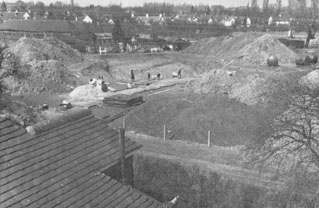
 |
Back to start |
The choice of site was not a wide one. The pool must obviously have a sufficiently clear south aspect to get the maximum amount of sunshine, and at the same time be sheltered from the wind. It must cause the minimum disturbance to neighbours. Only one area in the school estate finally commended itself. Fortunately for "public relations", it had long been set aside for the building of a Hall and swimming pool; plans for both of them had been prepared as early as 1937, and copies made available to the local authorities; they were in fact on display in Letchworth in 1943 as part of a town exhibition of post-war building plans. A hole had actually been dug on this site in 1939, and it was not filled in till 1957. Outline planning permission for a swimming pool had been granted in the latter year, so there was fortunately no question of taking the School's neighbours by surprise.
The dimensions of the pool were controlled by the new safety regulations laid down by the Ministry of Education and the Amateur Swimming Association, affecting both depth for diving and width of clearance opposite springboards. The ideal, of course, would be three separate pools, a shallow one for learning, a long one for swimming and a deep one for diving; ours was the most effective compromise between the three that we could devise, providing a shallow section for juniors, six "lanes" side by side for racing, and ample diving clearance made possible by the addition of a diving bay.

|
The hole in the ground, March 1962. |
| Back to previous. | Continue to next page. |
| Back to start | |